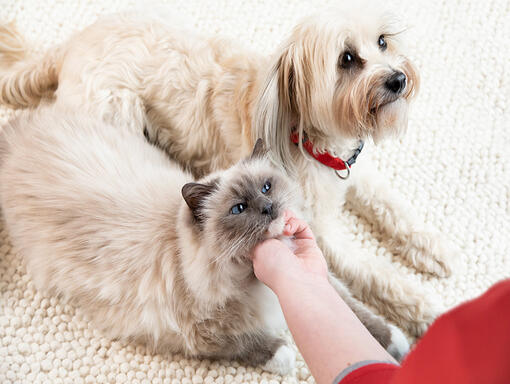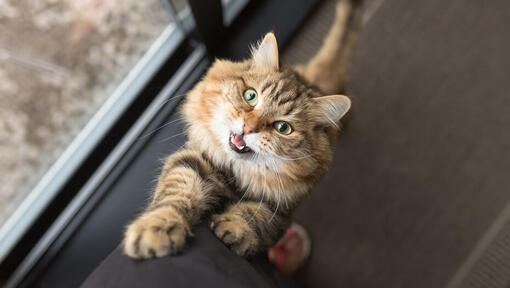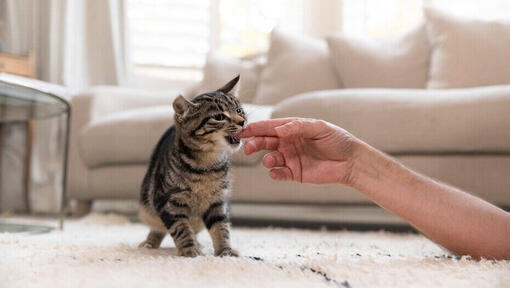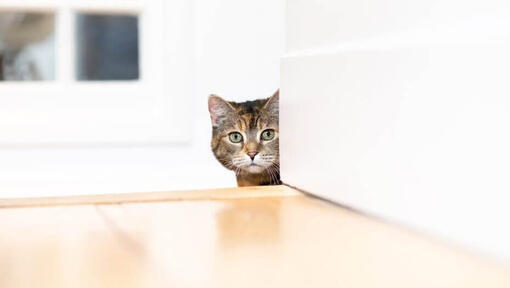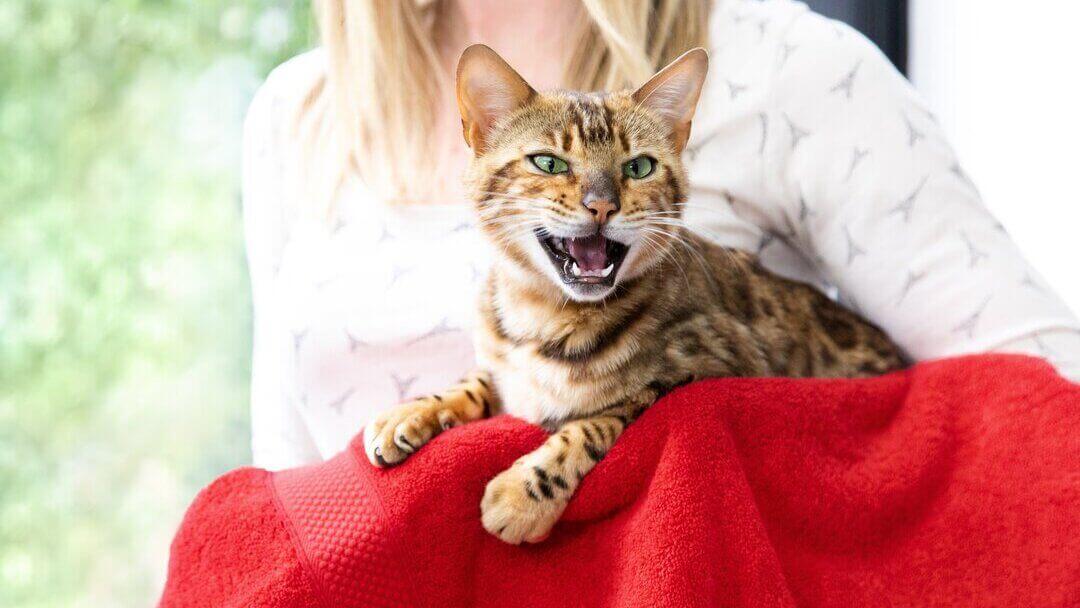
Your cat probably has lots of quirky habits, which is one of the many reasons they’re so much fun to be with. But sometimes their behaviour can surprise you – maybe yours has been scratching and clawing things you don’t want them to, for example, or shredding an innocent pair of curtains. However, some of these behaviours can pose a danger to people, such as aggressive-related behaviours, for example. Aggressive cats can not only cause serious injuries to people, but they can also transmit diseases that can lead to a serious health problem (i.e., cat scratch disease).
Cats use aggression for many reasons, such as catching and killing prey, defending themselves and their territory, deterring competitors, out of fear, or because they are ill. As cats are predators, aggression is an integral part of their behaviour when they are hunting. However, it is important to note that hunting and other forms of aggression are neurophysiologically very distinct. Additionally, during play, they may exhibit hunting-like behaviours that can trigger challenging moments with the family. For all these reasons, it is crucial that if your cat displays aggressive behaviours, you consult with your vet specialized in behavioural medicine as soon as possible.
Hopefully your cat shouldn’t show aggression towards you at home, but if they do there are certain things you can do to understand any issues.
Why is my cat aggressive?
If your cat is being aggressive, you need to ask why. Are they fearful or anxious about something? Are they in pain? Are they defending their territory? Are they simply playing too boisterously and not keeping their teeth and claws in check?
There are many reasons why cats demonstrate aggressive behaviour, and most of them are normal, if not inappropriate for a home environment.
Sometimes it’s temporary, caused by immediate circumstances (perhaps they’ve stumbled across an enemy cat), while sometimes it’s more in-built into your cat’s personality – a lack of socialisation and handling at a young age is often a common cause of aggression.
It’s always a good idea to get your cat checked over by a vet if they have become aggressive, just to make sure their behaviour isn’t the result of pain or another illness (such as, for example, neurological disorders). Pain-induced aggression is common, so if your vet can make your cat more comfortable, they’ll probably be a lot less irritable.
What to do if your cat bites you
Although it may be a shock, try to keep calm if you’re scratched or bitten by your aggressive cat, as shouting, sudden movements and physical retaliation will only increase your cat’s reaction, and make them less likely to accept fuss in the future. As much as possible, try to protect yourself without making sudden movements. Once it has calmed down, confine it to a room where you can provide water, food, its litter box, and a resting area. Finally, remember, it's very important that during the attack, you don't lock yourself in a room, as it might be difficult for you to get out later if the aggression continues.
After the attack, be sure to wash any scratches or bites promptly in warm, soapy water and treat them with antiseptic cream. Seek medical advice if the scratch gets infected or if you develop any symptoms, such as a fever, headache or swollen lymph glands.
Inappropriate games
During play time it’s common for your cat to view whatever they’re playing with as ‘prey’, especially those objects that move quickly, so never play by moving your hands or feet, or you might be attacked and scratched. Instead, use a fishing rod-style toy or a remote-controlled toy to play with your pet at a safe distance.
Redirected hunting games are often seen in indoor cats that have limited opportunities to express their natural predatory behaviour, which is why they may sometimes lie in wait behind a door and pounce on you as you pass. As with most cat behaviour problems it’s best to ignore it.
Stand still, be silent and don’t react. If you do nothing, your cat will lose interest. If you suspect they’re about to pounce on you, divert their attention by rolling a toy across the room for them to chase.
Sometimes, your cat will seem to become fixated on another animal or object, such as the sight of a bird through the window, and you can clearly see from their body language that they’ve gone into ‘predator mode’. Talking to them in a reassuring voice before approaching them can help snap them out of their focused state or try rolling a ball of paper past them to distract them safely.
Cat behaviour problems associated with aggression
There are several scenarios that would prompt a cat to react with aggression. It’s important to recognise which type of aggression it is to try and find an appropriate solution. Here are the most common types, but it's important to remember that it's a dangerous situation, and you should consult with your vet if your cat is aggressive:
Aggression that occurs during play
Play aggression occurs more often than you might think. It can in some cases result in injuries to people and can involve stalking, grasping, biting, scratching, attacking, or pouncing. Your cat might turn aggressive during play when they’re under-stimulated or have an excess of energy which they will try to get rid of by being overly active and hostile.
Maternal aggression
All mothers are known to be highly protective of their offspring, cats included. Maternal aggression takes place when the cat perceives a threat and feels like their kittens might be in danger. Normally, this would happen in the presence of other animals, but it can sometimes be directed towards people as well. However, maternal aggression shouldn’t last more than three to four weeks which is when the new-born kittens are at their most vulnerable.
Predatory aggression
Cats have predatory instincts and although it’s usually displayed towards other animals and birds, some might claim that it can also be directed towards people. However, it's hard to believe that cats see us as potential prey due to our large size (cats typically hunt prey much smaller than themselves). When they try to "hunt" us, it's usually because they are playing with parts of our body (hands or feet, mainly), not because they have a real intention of hunting and killing us.
However, as mentioned previously, if it hides and silently attacks as you walk down the hallway or tries to bite your hands or feet every time you move them, seek advice from your vet specialised in behavioural medicine.
Petting aggression
Unlike dogs, not all cats are not big fans of petting. Some can even find unpleasant or frightening (moreover, rarely, they might perceive it as painful). Pay close attention to your cat’s behaviour whenever you’re trying to pet them and try to notice what their trigger is. Maybe they only enjoy having their head or back touched so avoid touching their other body parts that trigger their aggression.
Food aggression in cats
This type of aggression is shown by cats towards other animals or people in their household who might come too close to their food. In these cases, your cat will perceive others as a threat and will do their best to keep them away by growling, hissing, or even attacking. Eating in the presence of other pets or people can cause stress and anxiety so in order to avoid food aggression in your cat, the best solution is to place their food in a secluded place where they can feel safe. However, it's important to highlight that it's much less common than, for example, in the case of dogs. Cats, due to their social characteristics, tend to be less competitive with food.
Aggression due to a lack of early socialisation
As the name indicates, cats that have not been properly socialized as kittens can grow up to become more aggressive. In this case, it is a fear-related aggression. If you have a multi-pet household and want to introduce such a cat to them, the best way to do this is by gradually exposing them to the others, one by one. With time, your cat could learn that there’s no reason to be frightened and protective.
Aggression related to fear
Some animals react to fear by showing aggression. This makes them feel in control and it’s a defence mechanism that has helped them survive so far. They will flatten their ears, show their teeth, hiss, and even attack, especially when they have no escape route. When this happens, your cat might feel threatened by something in the household so try to identify the reason and make sure your cat feels safe. Creating a safe area where the cat can take refuge can be very useful to prevent attacks; in other words, the cat should be provided with the opportunity to hide and avoid conflict situations if it deems it necessary.
Aggression to other cats at home
Cats can be quite solitary creatures, but they will usually get along quite happily with their feline family members. Many cats are very affectionate and loving with each other, while others will learn to tolerate each other and leave one another alone, providing they have enough space. But if their living area is too cramped, squabbles can erupt more often.
Cats are usually non-confrontational and prefer to run away from threatening situations, so if you have more than one cat make sure there are plenty of high up escape routes around the house, such as cat activity centres and uncluttered windowsills that they can retreat to if they get into a tiff. In multi-cat houses, it can also be highly beneficial to use a microchip cat flap, allowing each cat access only to their safe area. This way, control of the environment is given to the cat, reducing aggression among them.
However, just as there are all kinds of personalities in the human world, there are many different personalities in your pet’s world too, and some cats simply don’t like sharing their home with others or will take a dislike to a particular single cat. In these cases, the advice of a behaviourist can be helpful, although sometimes re-homing one of the cats is the safest and fairest option to all of them.
Take time and care in introducing new cats to the house, and never tell off or punish your existing cat if they’re not particularly welcoming to begin with, as this can lead to further negative associations. Give them time and space to get used to their new feline housemate and seek help from your vet or a feline behaviourist if necessary.
Aggression to neighbourhood cats
Aggression to neighbourhood cats is most commonly seen in unneutered male cats, who can be very territorial and competitive. Luckily, a lot of neutered cats are able to live together quite happily, or at least tolerate each other! They’ll try to avoid physical contact as much as possible, preferring posturing and meowing threats at each other, before eventually reaching a time-sharing agreement for favourite areas to explore.
In urban areas, however, where space is at a premium, cats can come to blows while they wait to use the same space. In this instance, try talking to your neighbours to see if you can arrange to let your cats out at different times, so they’re less likely to cross paths. It’s also a good idea to let your cats out only after they’ve been fed, so they’ll be more lethargic and contented.
Redirected aggression
Redirected aggression in cats can be a very serious issue as it tends to be highly intense. When a cat is motivated to attack (for whatever reason) but is unable to do so because, for instance, someone is holding them or there's a barrier in between, they may redirect their aggression towards people or other accessible animals. It's typical for this to happen when a cat sees another cat through a window or even when there's a sudden and loud noise (thunder, fireworks, etc.); in this case, the cat cannot access the source of the noise as it is intangible.
Frequently, when a cat redirects aggression towards a person, they can maintain their aggression (out of fear) for weeks or months. That's why it's important that when a cat is being aggressive or irritable, such as after seeing another cat through the window, you should not attempt to touch or separate them. It's better to wait until they relax before interacting with them.
If you want to learn more about the behaviour of cats, then take a look at our article on why cats follow their owners, next.
Explore our cat brands:
